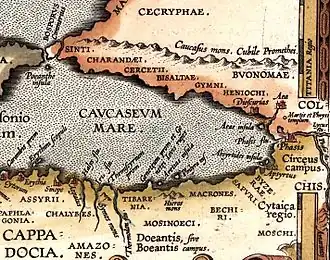Chalybes

The Chalybes (/ˈkælɪbiːz/; Ancient Greek: Χάλυβες/Χάλυβοι; Georgian: ხალიბები) and Chaldoi (Ancient Greek: Χάλδοι; Armenian: Խաղտիք, romanized: Xałtik') were peoples mentioned by classical authors as living in Pontus and Cappadocia in northern Anatolia during Classical Antiquity. Their territory was known as Chaldia, extending from the Halys River to Pharnakeia and Trabzon in the east and as far south as eastern Anatolia. According to Apollonius of Rhodes, the Chalybes were Scythians.[1]
The Chaldoi, Chalybes, Mossynoikoi, and Tibareni, are counted among the first ironsmith nations by classical authors.[2] Χάλυψ, the tribe's name in Ancient Greek, means "tempered iron, steel", a term that passed into Latin as chalybs, "steel". Sayce derived the Greek name Chalybe from Hittite Khaly-wa, "land of Halys River".[3] More than an identifiable people or tribe, "Chalybes" was a generic Greek term for "peoples of the Black Sea coast who trade in iron"[4] or "a group of specialised metalworkers".[5]
The main sources for the history of the Chaldoi are accounts from classical authors, including Homer, Strabo, and Xenophon. Xenophon encountered them during the march of the Ten Thousand to the Black Sea and describes them in his Anabasis as the "the most valiant of all the peoples [the Ten Thousand] passed through, and would come to hand-to-hand encounter." He reports that they dwelt in strongholds.[6] In Xenophon's Cyropaedia, Cyrus the Great helps the Armenians and Chaldians resolve a dispute over agricultural land.[7]
In Roman times, the Chaldaei (homonymous but unrelated to the Semitic Chaldeans[8][9]) and Chalybes are mentioned by Plutarch (Lucull. c. 14) as settled in Pontus and Cappadocia, or the Pontus Cappadocicus section of the Roman province of Pontus.
Pliny the Elder mentioned the Armenochalybes, a tribe residing between Trebizond and Armenia.[10]
Despite the ancient Greeks connecting the Chalybes to Scythians, some modern historians argue the Chalybes were a Georgian tribe. Historian Kalistrat Salia claims the Georgian ethnicity of the Chalybes is "indisputable". According to Sallia, the Zans, a Kartvelian ethnic group from present-day Turkey, are their descendants.[11] According to the 7th-century Geography of Armenia, the Chaldians called the Black Sea Kakamar, which may have an Indo-European etymology (the Greek root kak- 'ill' + mar, the Indo-European root for 'sea').[12]
See also
References
- ^ Apollonius Rhodius. Tr. by R. Merkel, by Edward P. Coleridge. The Argonautica. pp. 49, 65. [1]
- ^ Strabo, xi., 14.5
- ^ Vassaleva, Maya (31 December 1998). "Greek Ideas of the North and the East". In Tsetskhladze, Gocha R. (ed.). The Greek Colonisation of the Black Sea Area. Franz Steiner Verlag. p. 74. ISBN 978-3515073028. Retrieved 11 November 2020.
- ^ Diakonoff, I. M. (1984). The Pre-History of the Armenian People. Translated by Lori Jennings; with revisions by the author. Delmar, N.Y.: Caravan Books. pp. 116–117. ISBN 9780882060392.
[…] the Greeks evidently used the name Chalybes for all of the inhabitants of the Pontus who traded in iron ore (see Pauly, s.v. Chalybes); in some cases we might suspect that the Moschi (in Pontus) and/or the Chalybes were foreign designations for the Chaldians (Haliṭu, Xałtikʻ) who actually did live between the Tibareni in the west, the Mosynoeci in the north, and the Matieni in the southeast.
- ^ Erb-Satullo, Nathaniel L.; Gilmour, Brian J.J.; Khakhutaishvili, Nana (2020). "The metal behind the myths: iron metallurgy in the south-eastern Black Sea region". Antiquity. 94 (374): 401–419. doi:10.15184/aqy.2020.16. S2CID 216245696.
- ^ Xenophon. Anabasis. Book 4, Chapter 7, Sections 15–17.
- ^ Xenophon. Cyropaedia. Book 3, Chapter 2.
- ^ Diakonoff 1984, p. 162.
- ^ Paradeisopoulos, Iordanis K. (2013). "A Chronology Model for Xenophon's Anabasis". Greek, Roman, and Byzantine Studies. 53: 662.
- ^ Pliny. The Natural History. Book 6. Chapter 10
- ^ Salia, Kalistrat (1983). History of the Georgian Nation. Madison, WI: University of Wisconsin. p. 181.
- ^ Hewsen, Robert H. (2001). Armenia: A Historical Atlas. University of Chicago Press. pp. 27–28.
Bibliography
- Kavtaradze, Giorgi Leon (1996). "Probleme der historischen Geographie Anatoliens und Transkaukasiens im ersten Jahrtausend v. Chr". Orbis Terrarum (in German). 2: 191–216.
- Lang, David Marshall (1966). The Georgians. Ancient Peoples and Places. London: Thames and Hudson. pp. 50, 66, 75. ISBN 9780500020494. OCLC 956752.
Further reading
- Bittarello, Maria Beatrice (2022). "The Chalybes as an Historical People". Helios. 49 (2): 147–176. doi:10.1353/hel.2022.a904791. ISSN 1935-0228.